In the world of continuous improvement methodologies, the Gemba walk stands as an indispensable practice for organizations striving for excellence. This insightful journey into the history of Gemba walk not only unravels its roots but also sheds light on its transformative impact on businesses worldwide.
What is Gemba Walk?
Gemba Walk is a management practice that originated in Japan, particularly within the context of the Toyota Production System (TPS). The term “Gemba” translates to “the actual place” or “the real site” in Japanese. A Gemba Walk involves leaders or managers going to the actual location where work is performed to observe, understand, and gain insights into the processes, operations, and activities.
Gemba Walk is also a powerful methodology for promoting a culture of continuous improvement, enhancing communication, and driving positive change within an organization. It aligns with the philosophy of “going to the source” to truly understand and optimize processes.
Origin and History of Gemba Walk
The term “Gemba” itself originates from Japanese, translating to “the actual place” or “the real site.” Introduced by Taiichi Ohno, the father of the Toyota Production System, Gemba walk emerged as a cornerstone of lean manufacturing. Ohno believed that to truly understand a process, one must go to the source – the Gemba – where the work is done.
Taiichi Ohno’s Vision

Taiichi Ohno (1912–1990) was a Japanese industrial engineer and businessman, best known as the father of the Toyota Production System (TPS), which laid the foundation for lean manufacturing. Born in Dalian, China, Ohno joined Toyota in 1932 and played a pivotal role in transforming the company’s production processes.
In the mid-20th century, Taiichi Ohno envisioned Gemba walk as a holistic approach to identify waste, inefficiencies, and improvement opportunities in the manufacturing process. By physically being present on the shop floor, he aimed to foster a culture of continuous improvement and empower employees to actively participate in problem-solving.
Evolution of Gemba Walk Beyond Manufacturing
As lean principles expanded beyond manufacturing, Gemba walk found applications in various industries. From healthcare to software development, the concept evolved to encompass any space where work is executed. The essence remained the same – the importance of observing processes firsthand to enhance efficiency and quality.
Through case studies showcasing successful implementations, you will witness the transformative impact of putting people at the center of Gemba practices. From frontline workers to upper management, Gemba walks become a catalyst for collaboration, communication, and continuous learning.
Key Components of Gemba Walk
Observation: At the heart of this walk lies the art of observation. This involves physically being present where the work is done – the Gemba. Leaders keenly observe processes, workflows, and interactions to gain a deep understanding of how tasks are performed. This firsthand observation enables the identification of inefficiencies, bottlenecks, and areas of improvement.
The power of observation extends beyond surface-level scrutiny. Gemba walk encourages leaders to delve into the details, scrutinizing each step of a process to uncover hidden opportunities for optimization. By leveraging the sense of sight, leaders can gather valuable insights that might be overlooked in a traditional analysis.
Fostering Collaboration: This walk places a strong emphasis on direct engagement with frontline workers. Leaders actively communicate with employees who are directly involved in the daily operations. This interaction serves multiple purposes:
- Insight Gathering: Engaging with frontline workers provides leaders with firsthand knowledge of the challenges and obstacles faced by employees in their tasks.
- Employee Empowerment: By involving employees in discussions about processes and improvements, Gemba walk fosters a sense of ownership and empowerment. This involvement goes a long way in cultivating a culture of collaboration and innovation.
Real-Time Problem Solving: One distinctive feature of this walk is its commitment to real-time problem-solving. Rather than waiting for issues to escalate, leaders address challenges on the spot. This proactive approach prevents the compounding of problems and contributes to a more agile and responsive work environment.
Real-time problem-solving involves quick decision-making and implementation of solutions. Gemba walk encourages leaders to use their observations and insights to make informed decisions promptly. This immediacy is crucial in maintaining the flow of operations and preventing disruptions.
Things to Remember during Gemba Walk
Embarking on this walk is more than just a stroll through the workspace; it’s a strategic initiative aimed at uncovering opportunities for improvement. To ensure a productive and impactful Gemba walk, here are key considerations to keep in mind:
A successful Gemba walk requires a blend of strategic planning, active engagement, and a commitment to continuous improvement. By keeping these essential tips in mind, organizations can harness the full potential of Gemba walk as a dynamic tool for achieving operational excellence.
Types of Gemba Walk
The Gemba walk, rooted in the philosophy of direct observation at the workplace, comes in various forms tailored to specific organizational needs. Understanding the different types of Gemba walks allows businesses to deploy this powerful tool strategically. Let’s explore some key types of Gemba walks and their unique applications.

Standard Gemba Walks: It involves leaders and managers visiting the actual workplace to observe processes, workflows, and interactions. It serves as the foundational type, providing insights into daily operations. Standard Gemba walks are versatile and applicable across industries, making them a valuable starting point for organizations embracing continuous improvement.
Leadership Gemba Walks: Leadership walks involve top-level executives actively participating in Gemba walks. This type emphasizes the commitment of leadership to the principles of continuous improvement. When executives lead by example, it sends a powerful message throughout the organization, fostering a culture of engagement and accountability.
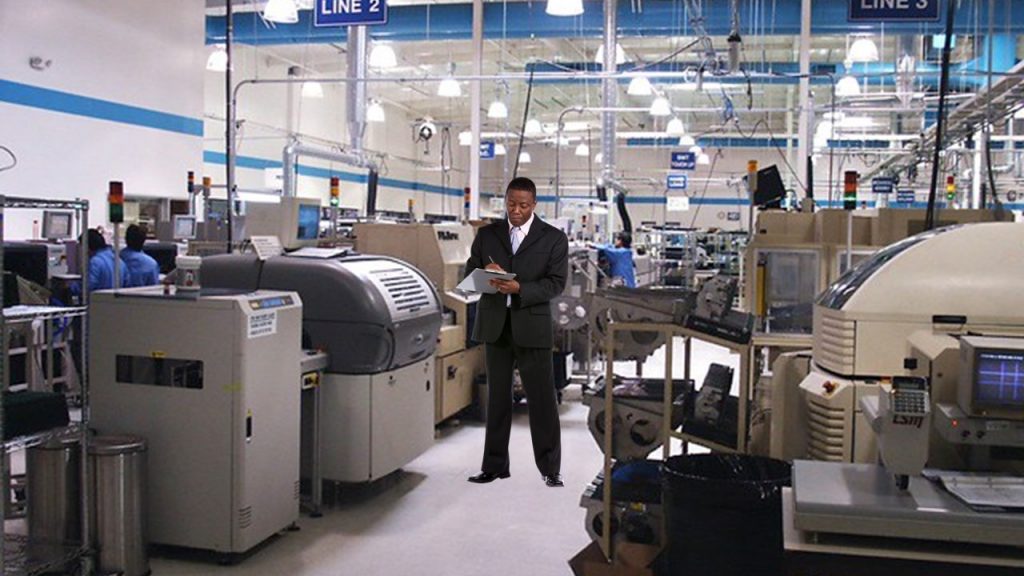
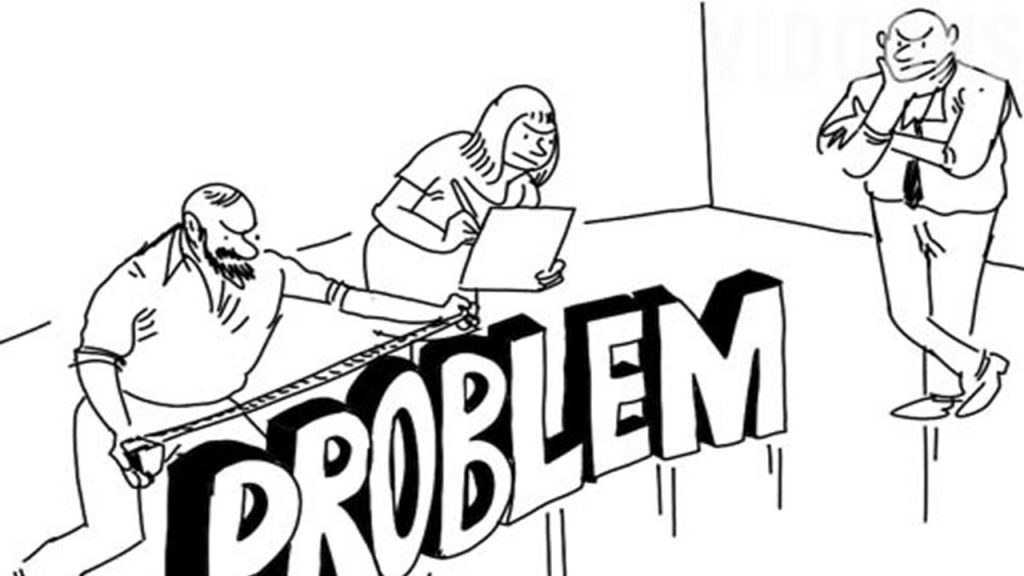
Gemba Walks for Problem-Solving: This type of walk is focused on addressing specific problems or challenges in real-time. Teams conduct targeted Gemba walks to identify and solve immediate issues affecting processes. By emphasizing swift problem resolution, this type prevents the escalation of challenges and contributes to a more agile and responsive organization.
Gemba Walks for Kaizen: Kaizen, the philosophy of continuous improvement, is central to this type of walk. Teams engage in systematic, incremental improvements during these walks, aiming to enhance efficiency, quality, and overall processes. Kaizen Gemba walks align with long-term strategic goals, ensuring that continuous improvement becomes ingrained in the organizational culture.
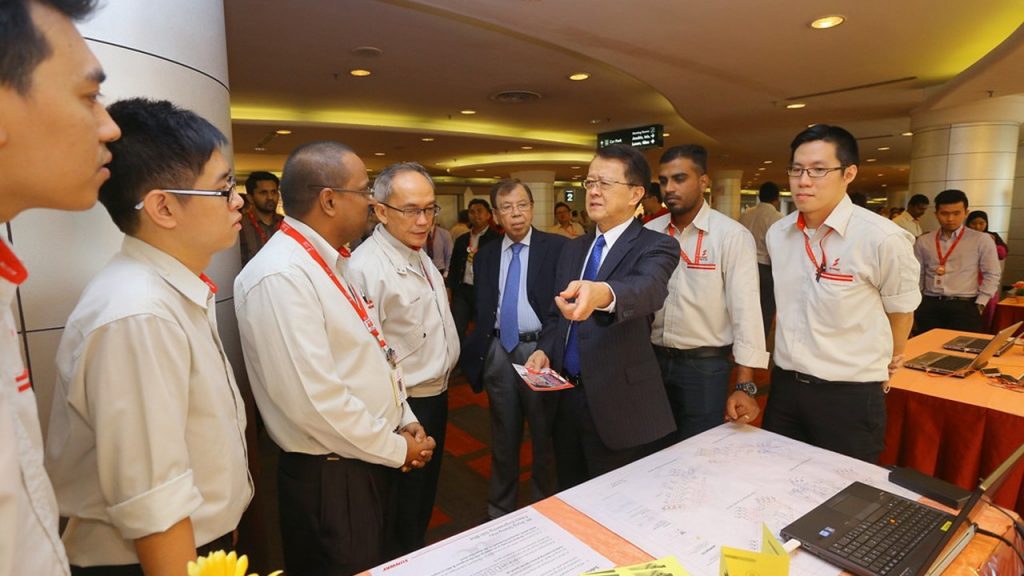
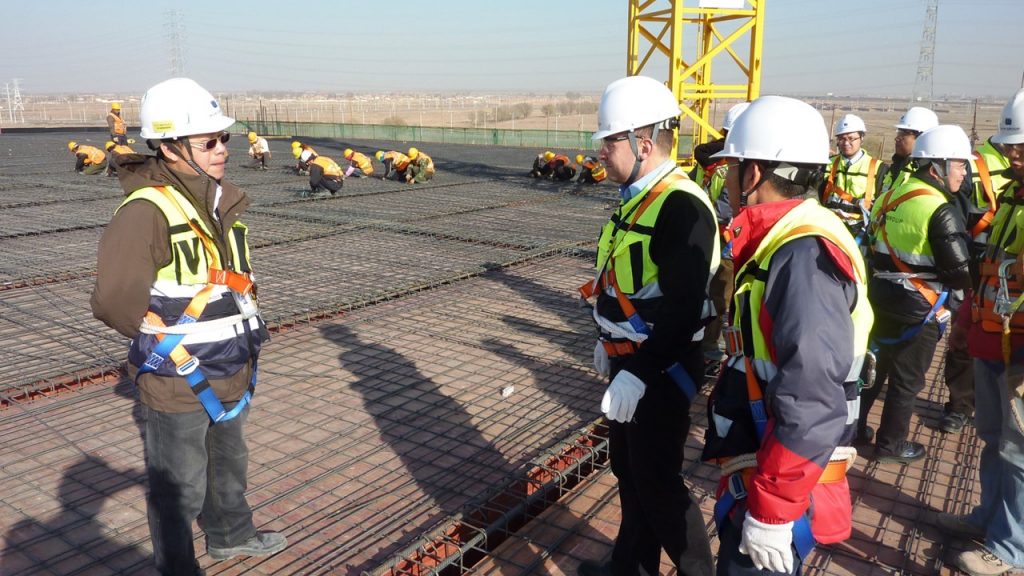
Gemba Walks for Safety: Safety-focused Gemba walks concentrate on identifying and addressing potential safety hazards in the workplace. Leaders, safety officers, and relevant personnel collaborate to ensure compliance with safety protocols and proactively address any concerns. This type of walk emphasizes the organization’s commitment to employee well-being.
Gemba Walks for Compliance: Compliance-driven Gemba walks are essential in industries with stringent regulatory requirements. Teams conduct these walks to verify adherence to industry standards, protocols, and legal regulations. This type of walk helps organizations maintain compliance, mitigate risks, and avoid potential legal issues.


Gemba Walks for Customer Focus: These type of walks revolve around understanding and improving processes that directly impact the customer experience. Leaders and teams actively seek insights into customer interactions, feedback loops, and service delivery. This type ensures that organizational processes align with and exceed customer expectations.
The effectiveness of these walks lies in aligning them with specific organizational objectives. Whether the focus is on continuous improvement, safety, innovation, or compliance, adapting Gemba walks to meet these goals ensures a targeted and impactful approach. Organizations that embrace various types of Gemba walks are better equipped to address diverse challenges and drive holistic improvement across their operations.
Steps to Follow in Gemba Walk
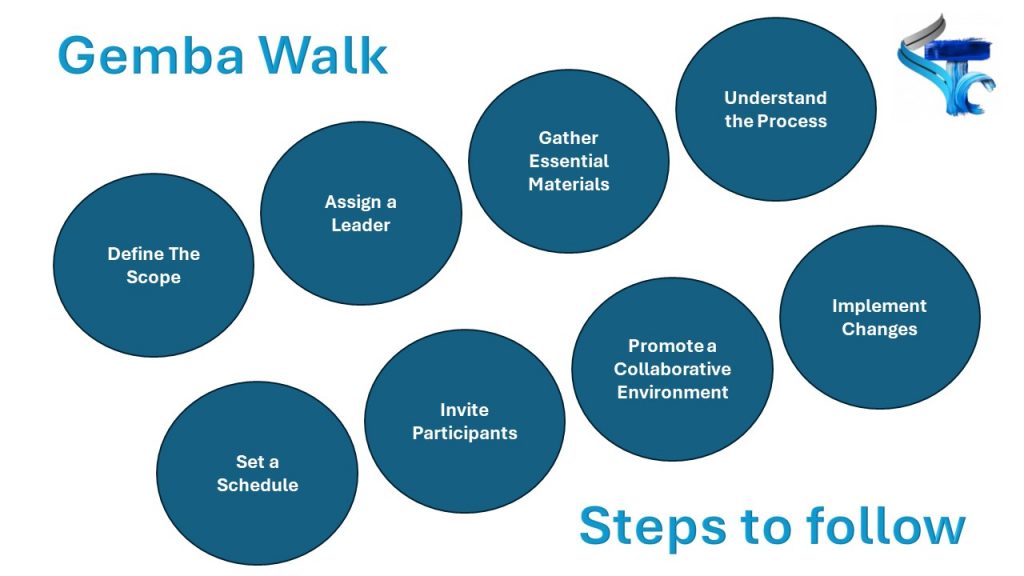
Define the Scope: Clearly outline the scope of the Walk. Identify specific areas or processes you want to assess and improve. For example, if the goal is to enhance efficiency, focus on aspects such as reducing idle time, decreasing waste, or mitigating health risks associated with the process.
Assign a Leader: Designate a knowledgeable leader to guide the Walk. This individual should have a deep understanding of the process, be able to answer questions, and effectively lead discussions. Their comfort with public speaking is crucial for facilitating a productive walk.
Gather Essential Materials: Ensure you have all necessary materials before commencing the walk. This includes a Gemba Walk Checklist, relevant standard operating procedure documents, safety data sheets, and any other documentation related to the process. Having these materials on hand facilitates a comprehensive assessment.
Understand the Process: The Walk leader should possess a thorough understanding of the process under scrutiny. This includes awareness of standard procedures, potential risks, and key elements that contribute to the overall workflow. This understanding is vital for effective observation and identification of improvement opportunities.
Set a Schedule: Establish a regular schedule for Walks. Consider the frequency of process changes, the impact on the team’s workload, and the overall objectives. A consistent schedule ensures that Gemba Walks become an integral part of continuous improvement efforts.
Invite Participants: Extend invitations to key participants who have in-depth knowledge of the process. These individuals should be able to represent the team’s experiences accurately. Their participation not only contributes valuable insights but also enhances the overall Walk experience.
Promote a Collaborative Environment: Foster a collaborative atmosphere during the Walk. Emphasize that the goal is collective improvement, and encourage open communication among all participants. This inclusive approach ensures that diverse perspectives are considered.
Implement Changes: Based on the documented action items, initiate the implementation of changes. Work collaboratively with the team to address identified areas for improvement. This step completes the Walk cycle, turning observations into tangible enhancements.
Building Effective Feedback Loops in Gemba Walks
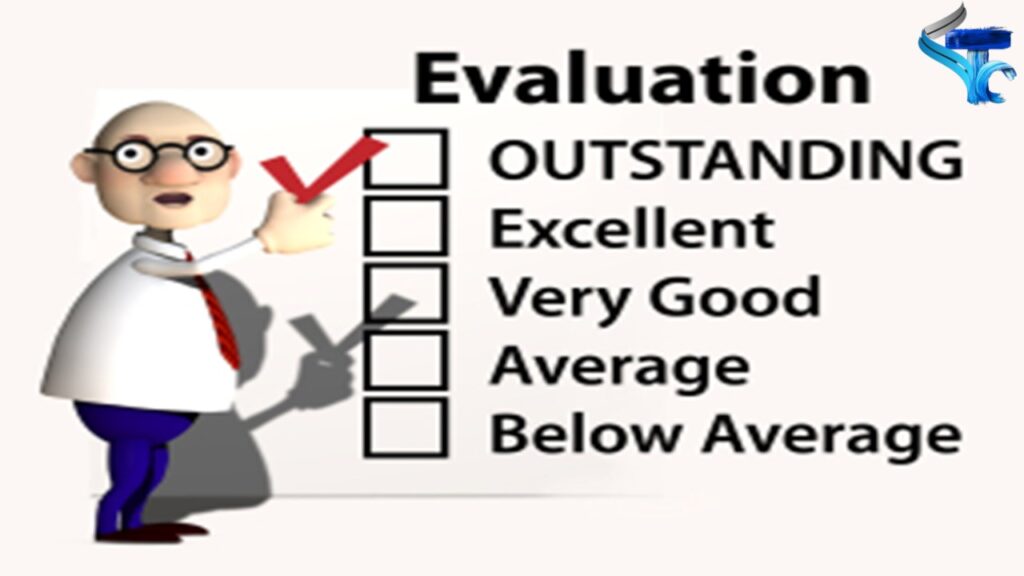
The Gemba walk is not just about observation; it’s a dynamic process that thrives on feedback and continuous improvement. Establishing robust feedback loops and mechanisms during Gemba walks is crucial for maximizing their impact. Here are the steps to building effective feedback mechanisms that drive continuous improvement:
Step 1: Define Clear Objectives for Feedback: Before embarking on a Gemba walk, establish clear objectives for the feedback process. Outline what specific insights you aim to gather, whether it’s identifying inefficiencies, improving safety protocols, or enhancing employee engagement. Clearly defined objectives provide a roadmap for feedback collection.
Step 2: Encourage Open Communication: Foster an environment of open communication during Gemba walks. Encourage team members, including frontline workers, to share their observations, concerns, and improvement ideas. Emphasize that feedback is valued and essential for driving positive change.
Step 3: Utilize Technology for Real-Time Feedback: Incorporate technology to facilitate real-time feedback during Gemba walks. Mobile apps, tablets, or digital forms can streamline the feedback collection process. This approach allows for immediate documentation of observations, ensuring that insights are captured without delay.
Step 4: Implement Regular Checkpoints: Establish regular checkpoints during Gemba walks to discuss findings and gather initial feedback. These brief pauses in the walk provide an opportunity to address immediate concerns, validate observations, and make real-time adjustments to the feedback collection process.
Step 5: Diversify Feedback Channels: Offer multiple channels for feedback to accommodate different communication styles. While face-to-face discussions are valuable, consider incorporating anonymous suggestion boxes, digital surveys, or online platforms. Diversifying feedback channels ensures a more comprehensive understanding of the Gemba.
Step 6: Include Frontline Workers in Feedback Sessions: Frontline workers possess invaluable insights into day-to-day operations. Include them in feedback sessions to gain a deeper understanding of their perspectives. This collaborative approach not only enhances the quality of feedback but also fosters a sense of ownership among employees.
Step 7: Document Observations Systematically: Develop a systematic approach to documenting observations. Use standardized templates or digital tools to ensure consistency and thoroughness. Well-documented observations serve as a foundation for meaningful analysis and the formulation of targeted improvement strategies.
Step 8: Establish a Continuous Improvement Team: Form a dedicated team responsible for analyzing feedback and driving continuous improvement initiatives. This team can consist of representatives from various departments, ensuring a holistic approach to addressing identified issues and implementing solutions.
Step 9: Prioritize Actionable Feedback: Not all feedback may require immediate action, but distinguishing between actionable and non-actionable feedback is crucial. Prioritize issues that directly impact efficiency, safety, or overall performance. This strategic approach ensures that resources are allocated where they can make the most significant impact.
Final Step: Close the Loop: Communicate Changes and Progress: Closing the feedback loop is essential for maintaining transparency and building trust. Communicate the actions taken based on feedback and provide updates on progress. This step demonstrates a commitment to continuous improvement and reinforces the value of feedback in driving positive change.
Gemba Walk Checklist
As leaders take to the actual workplace to observe, engage, and drive positive change, a well-prepared and systematic approach becomes paramount. The Gemba Walk Leadership Checklist serves as a guide for leaders to navigate this process effectively.
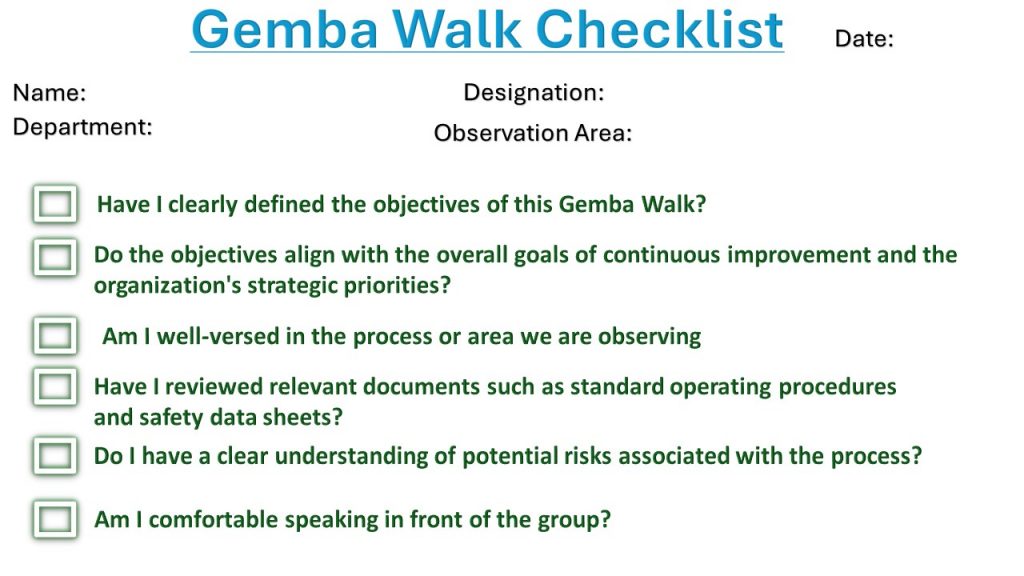
It encapsulates key elements that leaders should consider before, during, and after the Gemba Walk to ensure a focused, purposeful, and collaborative exploration of the workplace. From defining clear objectives to post-walk review planning, this checklist aims to enhance leadership preparedness and engagement during Gemba Walks, contributing to the success of continuous improvement initiatives within the organization.
Please download the PDF version of the checklist from here.
Conclusion
The Gemba Walk is not a one-size-fits-all endeavor; rather, it is a versatile approach that adapts to diverse industries, processes, and organizational needs. Whether reducing idle time, mitigating health risks, or fostering employee engagement, the Gemba Walk provides a lens through which leaders can identify, understand, and improve critical aspects of their operations.
Crucially, the Gemba Walk is not a standalone event but a continuous cycle of observation, engagement, and improvement. The checklist for leaders serves as a compass, guiding them through each step of the process—from setting clear objectives to planning post-walk reviews.
It emphasizes the importance of preparation, effective communication, and collaborative engagement with frontline workers, all essential elements in maximizing the impact of Gemba Walks.

![The Power of Storytelling in Corporate Training: Igniting Success and Inspiring Growth [2023]](https://trainercentric.com/wp-content/uploads/2023/06/storytelling-1024x576.jpg)

